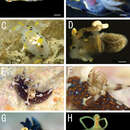Description
provided by Zookeys
Body (Figure 8A) 1.86 long, composed of swollen prosome and small 2-segmented urosome. Prosome composed of anterior region as cephalosome, middle region comprising first and second pedigerous somites, and posterior region as third pedigerous somite. Cephalosome (Figure 8B) not elongated, broad and unarmed with protruded rostral region (Figure 9A). Middle region (Figure 8B) compact, about as wide as long, bearing 3 pairs of lateral processes, without posterolateral processes. Posterior region (Figure 8B, C) broad, bearing paired bulbs carrying leg 3 on tip. Lateral processes (Figure 8A) long and slender, about twice as long as body length. Urosome (Figure 8C, D) small; genito-abdomen ampulla-like posterior portion bearing paired apertures without posterolateral lobes; opercula bearing small shield-like structure with 2 spiniform processes. Caudal ramus (Figure 8E) small, about 1.5 times as long as wide, bearing 6 setae and 2 dorsal spiniform processes; apical seta long, styliform.
Antennule (Figure 9A, B) 2-segmented; terminal segment divided by 2 constrictions making it appearing as original segmentation; proximal segment bearing 2 blunt spines; terminal segment bearing 2 blunt spines and 1 seta in proximal part, 3 setae and 1 blunt element in middle part, and 9 setae and 2 blunt elements in distal part. Antenna (Figure 9A, C) 3-segmented; coxo-basis broad, bearing 1 medial spine; proximal segment of endopod bearing 1 medial spine; terminal segment of endopod drawn out into strong apical claw, with 2 spines and 2 setal elements. Labrum (Figure 9A, C) bilobate, bearing flat surface. Mandible (Figure 9A, C, D) spatulate, tapering into single curved blade without dentiform processes. Labium (Figure 9A, C) with two patches of spinules. Maxillule not observed. Paragnath (Figure 9C) represented by pinnate lobe. Maxilla (Figure 9C, E) 2-segmented; syncoxa unarmed; allobasis tapering into spiniform process and bearing seta. Maxilliped absent.
Legs 1 and 2 (Figures 8B, 9F, G) unsegmented, weakly sclerotized; protopod bearing outer basal seta, largely incorporated into ventral wall of prosome; elongate exopodal lobe separated from small endopodal lobe; exopodal lobe drawn out into long process bearing multiple constrictions, wrinkly surface, and 4 setal elements; endopodal lobe bulbous, bearing spiniform apical element. Leg 3 (Figures 8C, 9H) represented by conical process with apical seta.
Egg sacs (Figure 8F) bilobate, bearing curved side and spiral side; dull white in live color (Figure 1E, F).
Variation of female morphology. The morphology of the female paratype is as in the holotype. The specimens from type series (n = 2) range from 0.71-1.86 (1.28 ± 0.81) BL.
- license
- cc-by-3.0
- copyright
- Daisuke Uyeno, Kazuya Nagasawa
- bibliographic citation
- Uyeno D, Nagasawa K (2012) Four new species of splanchnotrophid copepods (Poecilostomatoida) parasitic on doridacean nudibranchs (Gastropoda, Opistobranchia) from Japan, with proposition of one new genus ZooKeys 247: 1–29
- author
- Daisuke Uyeno
- author
- Kazuya Nagasawa

